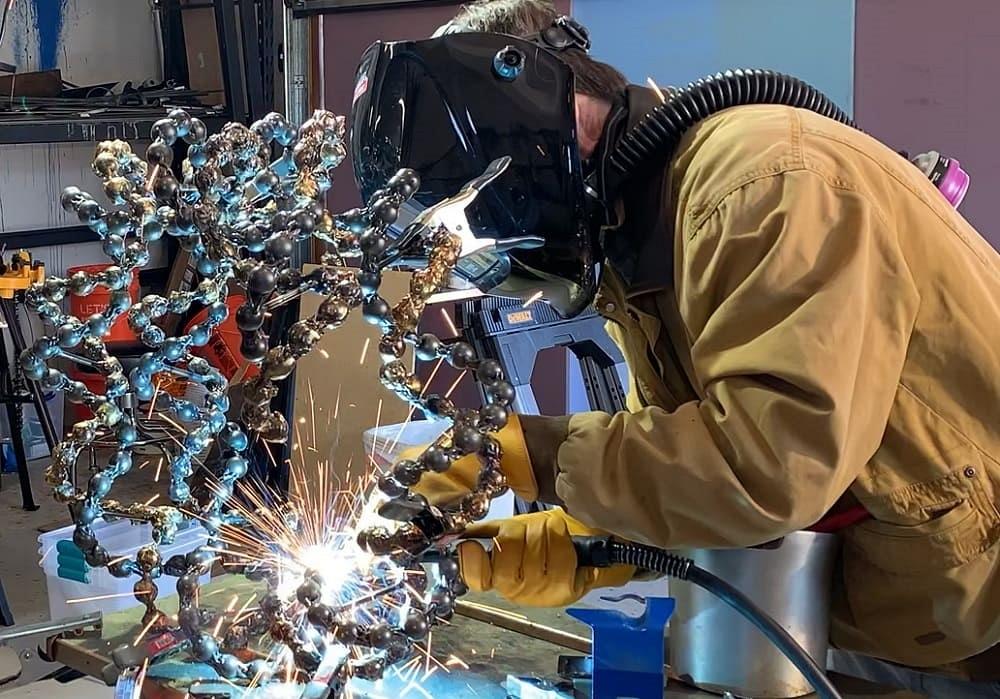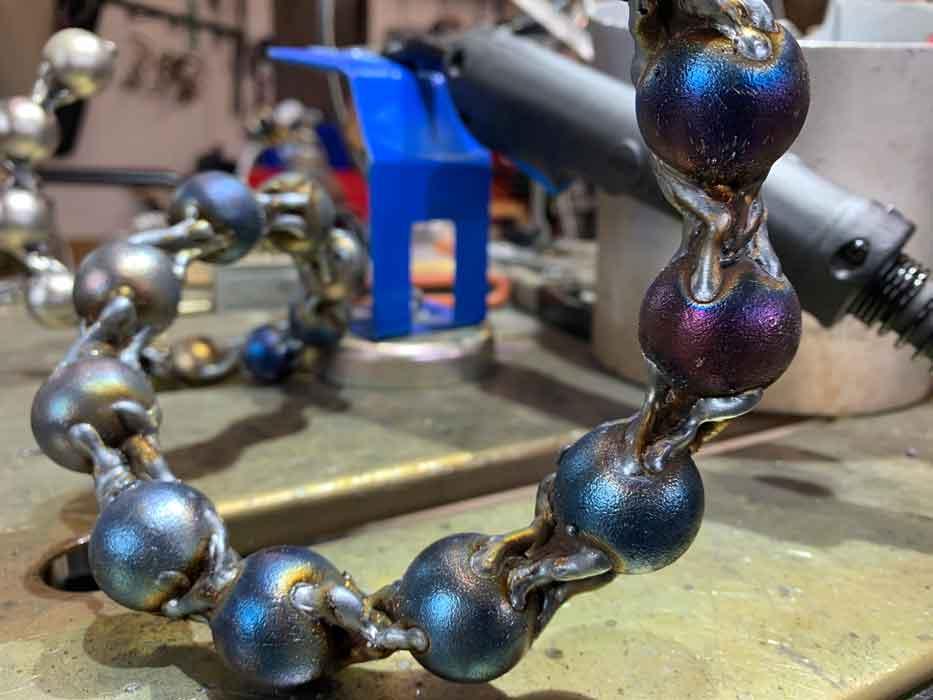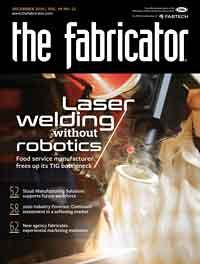- FMA
- The Fabricator
- FABTECH
- Canadian Metalworking
Categories
- Additive Manufacturing
- Aluminum Welding
- Arc Welding
- Assembly and Joining
- Automation and Robotics
- Bending and Forming
- Consumables
- Cutting and Weld Prep
- Electric Vehicles
- En Español
- Finishing
- Hydroforming
- Laser Cutting
- Laser Welding
- Machining
- Manufacturing Software
- Materials Handling
- Metals/Materials
- Oxyfuel Cutting
- Plasma Cutting
- Power Tools
- Punching and Other Holemaking
- Roll Forming
- Safety
- Sawing
- Shearing
- Shop Management
- Testing and Measuring
- Tube and Pipe Fabrication
- Tube and Pipe Production
- Waterjet Cutting
Industry Directory
Webcasts
Podcasts
FAB 40
Advertise
Subscribe
Account Login
Search
Metal in his DNA: Doctor welds nucleosomes structures
Cancer researcher and metal artist honors scientists with sculptures
- By Sue Roberts
- December 7, 2019
- Article
- Shop Management

Dr. Bryan Welm, cancer researcher by day, welds nucleosomes structures in his free time. Photo provided by Dr. Bryan Welm
What does cancer research and welding have in common? To begin with, Dr. Bryan Welm, a researcher at the University of Utah’s Huntsman Cancer Institute in Salt Lake City … and weekend welder.
One of Welm’s 2-foot-diameter metal sculptures looks a bit like something from interstellar space. But rather than looking skyward, an art aficionado needs to look within to find his miniscule model—a microscopic nucleosome. Nucleosomes are biomolecular protein structures found in individual cells. They wrap around DNA similar to a thread wrapping around a spool.
Welm’s nucleosome sculptures, welded together from 70 lbs. or more of steel and mounted on stone bases that can approach 200 lbs., are about 50 million times larger than the real-life counterparts. Nucleosomes were discovered by Dr. Karolin Luger, an Austrian-American biochemist and biophysicist, who was honored as the recipient of a nucleosome sculpture.
Finding a Blueprint
A visit to a government database that acts as a depository for structural information on proteins studied by scientists is a typical first step in the development of one of the nucleosome sculptures. The second step is greatly amplifying and enlarging the miniscule dimensions to human-friendly inches. The third step is creating a wax, clay, or 3D-printed model to serve as a draft for the final version of the sculpture. Welm’s daughter, whose artistic talent leans toward drawing, assists with creating 2D blueprints and fine-tuning the final plans.
An Institute colleague, Dr. Brad Cairns, chairman of the Department of Oncological Sciences, also contributes nucleosome expertise to help ensure that the metal version is as precise as possible.
“Brad is researching structural biology to advance the understanding of the nucleosome and other proteins. He contributes a lot of great insight about their biology. Every few weeks we will spend a weekend working on different parts of a sculpture to be sure it is accurate,” Welm said.
Why Weld?
Welm’s fascination with welding began when he was young.
“I would see pictures of welders wearing what looked like space suits and there would be sparks flying and steel flowing. To me they were mysterious, strong, and powerful people who created interesting metal objects,” he said.
His own hands-on welding experience started about two years ago when he took a gas metal arc welding class for beginners at the Kimball Art Center in Park City, Utah. That led to requisitioning part of his garage as a workshop to house his projects and a Millermatic 215.
Mild steel provided with a colorful patina finish is the main material, but wood, stone, or glass might be part of the design.

A section of a sculpture’s DNA strand is being assembled using gas metal arc welding. Photo provided by Dr. Bryan Welm
A nucleosome sculpture can require thousands of welds and may take several months of evenings and weekends to complete. But, Welm said, the welding provides him with a welcome alternative to his scientific endeavors.
“Welding takes a lot of focus and gets me out of my medical research mindset. It puts me in a calm place.”
Research and Welding Parallels
“Cancer research and welding have similarities,” Welm said. “Both require developing hypotheses—conceptualizing and thinking about a problem and building up to a resolution. In science you develop concepts to be tested. In metal work you think about how to create.
“In research failure is not uncommon. A concept fails and you reconceptualize or readdress the biomedical problem. With welding, a weld might fail so you try something different. Eventually you can get to the answer or build you want.
“The difference is their time frames. It may take months before a scientific experiment works. It provides delayed gratification. With welding it may take only a few minutes to come up with another idea and try again after a failure. Gratification is almost instant.”
Three Goals
Some of Welm’s sculptures are commissioned. Others come into existence to satisfy his own criteria. His three goals are:
Bring attention to a scientific achievement. “A researcher struggles to achieve a big discovery that the public might never know about. I like to honor the investigator by building a sculpture that represents his or her work,” he said.
Create something that can be used for education while promoting public awareness. “To the best of my ability, I build sculptures to the same dimensions as the proteins so trainees can actually see what a nucleosome looks like without a microscope.”
Raise funds for research. “I look for a project sponsor to donate to the Huntsman Cancer Foundation and purchase materials.”
A constant learner, Welm has recently added glass bending to his skills and plans to expand his welding abilities.
“I love the learning aspect of welding. I would like to take a sabbatical to spend time with metalworkers to learn some techniques and other types of welding. It’s amazing what people can do with metal.”
About the Author

subscribe now

The Fabricator is North America's leading magazine for the metal forming and fabricating industry. The magazine delivers the news, technical articles, and case histories that enable fabricators to do their jobs more efficiently. The Fabricator has served the industry since 1970.
start your free subscription- Stay connected from anywhere

Easily access valuable industry resources now with full access to the digital edition of The Fabricator.

Easily access valuable industry resources now with full access to the digital edition of The Welder.

Easily access valuable industry resources now with full access to the digital edition of The Tube and Pipe Journal.
- Podcasting
- Podcast:
- The Fabricator Podcast
- Published:
- 04/16/2024
- Running Time:
- 63:29
In this episode of The Fabricator Podcast, Caleb Chamberlain, co-founder and CEO of OSH Cut, discusses his company’s...
- Industry Events
16th Annual Safety Conference
- April 30 - May 1, 2024
- Elgin,
Pipe and Tube Conference
- May 21 - 22, 2024
- Omaha, NE
World-Class Roll Forming Workshop
- June 5 - 6, 2024
- Louisville, KY
Advanced Laser Application Workshop
- June 25 - 27, 2024
- Novi, MI
































